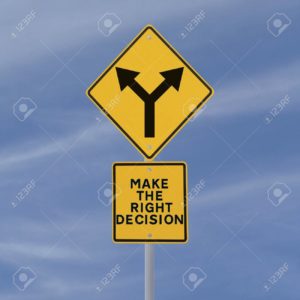“My Decision Maker”
What is it? Where is it? What are my options?
On Ken Wapnick’s Chart of Course Metaphysics, his diagram depicts ‘the how and why’ of believing we are in the world, and more importantly, how we ‘get back’ to our true Identity in Heaven. The primary and most important concept central to the whole chart is the decision maker (DM). Ken describes it as that internal part of us in our mind that chooses whether to take the tiny mad idea of separation seriously (the ego)… or not, and see it as silly (the Holy Spirit).
The reason why the “decision maker” is so pivotal is that is where all our seeming trouble started when we started believing we separated from God (i.e. ego)… so when we get back to the mind and specifically to our decision maker and choose again, our belief in our woes will end and we will experience peace.

So first off…. what is it? How would we describe this decision maker (DM)? Regretfully, after running to Ken Wapnick’s Glossary for ACIM for a quick pat answer… it was not there. He did describe the Course’s view of “decision” however:
Decision: the last remaining freedom as prisoners of this world is our power to decide; while unknown in Heaven, decision is necessary here as it was our decision to be separate from our Source that must be corrected; this is accomplished by choosing the Holy Spirit instead of the ego, right-mindedness instead of wrong-mindedness. (Ken Wapnick’s Glossary)
A couple things implied in the above definition… there seems to be a part of us that can and does decide, and it’s a decision between one of two choices, the ego or Holy Spirit. The inference in the last part above in Ken’s definition is that the choice takes place in our “mind,” where we pick an experience of right-mindedness, the Holy Spirit… or wrong-mindedness, the ego.
The Course itself only uses the phrase decision maker one time (Manual p.17, par.2, L.7)… although it is a reference to the ego making the body with its brain the decision maker instead of the mind, in order to protect the ego’s own anonymity from our awareness:
… it is obvious that decisions are of the mind, not of the body. If sickness is but a faulty problem-solving approach, it is a decision. And if it is a decision, it is the mind and not the body that makes it. The resistance to recognizing this is enormous, because the existence of the world as you perceive it depends on the body being “the decision-maker.” (Man. p.17)
———————————————–
The DM is talked about (without being mentioned per se), in a number of places in the Course, as that part of our mind which chooses between one of two thought systems.
————————————————–
Jesus does use a phrase twice that is synonymous with the decision maker: he refers to the mind as “the mechanism of decision.” Once in Chap. 8:
Your mind is the means by which you determine your own condition, because mind is “the mechanism of decision.” It is the power by which you separate or join, and experience pain or joy accordingly. My decision cannot overcome yours, because yours is as powerful as mine. If it were not so the Sons of God would be unequal. All things are possible through our joint decision, but mine alone cannot help you. Your will is as free as mine, and God Himself would not go against it. (Text p. 145, par.5)
And once in Chap. 12:
This world you made is therefore totally chaotic, governed by arbitrary and senseless “laws,” and without meaning of any kind. For it is made out of what you do not want, projected from your mind because you are afraid of it. Yet this world is only in the mind of its maker, along with his real salvation. Do not believe it is outside of yourself, for only by recognizing where it is will you gain control over it. For you do have control over your mind, since the mind is “the mechanism of decision.”
10 If you will recognize that all the attack you perceive is in your own mind and nowhere else, you will at last have placed its source, and where it begins it must end. For in this same place also lies salvation. The altar of God where Christ is, is there.
From this place, where God and His Son dwell in peace and where you are welcome, you will look out in peace and behold the world truly. Yet to find the place, you must relinquish your investment in the world as you project it, allowing the Holy Spirit to extend the real world to you from the altar of God. (Text p.222, par.9-10)
——————————————————————-
In the following two paragraphs from section V of Chap.31, p.658…. Jesus talks about the part of us (the decision maker aligned with the ego) that chooses between the two internal wrong minded images of ourselves that we project onto others and our seeming self as bodies in the world: a guilty victimizer or a seemingly innocent self (the victim: the ‘face’ of innocence)…
12 There is an alternate about the thing that you must be (a victimizer or the victimized). You might, for instance, be the thing you (as an ego) chose to have your brother be. This shifts the concept of the self from what is wholly passive (victim), and at least makes way for active choice, and some acknowledgement that interaction must have entered in. There is some understanding that you chose for both of you, and what he represents has meaning that was given it by you. It also shows some glimmering of sight into perception’s law that what you see reflects the state of the perceiver’s (wrong) mind. Yet who was it that did the choosing first? If you are what you chose your brother be, alternatives were there to choose among, and someone (my internal decision maker) must have first decided on the one to choose, and let the other go.
13 Although this step has gains, it does not yet approach a basic question. Something (our decision maker) must have gone before these concepts of the not-self. And something (my DM) must have done the learning which gave rise to them. Nor can this be explained by either view. The main advantage of the shifting to the second (victimizer) from the first (victim) is that you somehow entered in the choice by your decision. But this gain is paid in almost equal loss, for now you stand accused of guilt for what your brother is. And you must share his guilt, because you chose it for him in the image of your own. While only he was treacherous before, now must you be condemned along with him. (Text p.658)
Lesson 152: “The power of decision is my own.”
Jesus could have alternatively said … The power of the decision maker is my own.
1. No one can suffer loss unless it be his own decision. No one suffers pain except his choice elects this state for him. No one can grieve nor fear nor think him sick unless these are the outcomes that he wants. And no one dies without his own consent. Nothing occurs but represents your wish, and nothing is omitted that you choose. Here is your world, complete in all details. Here is its whole reality for you. And it is only here, salvation is (in the mind at the level of the decision maker’s choice between ego and Holy Spirit). (Les. 152)
————————————
Although the Course only uses the phrase decision maker one time, it does use the term “maker” 35 times. And it is in reference to our DM aligned with the ego and the story of separation we “make up.” Check out the first time ‘maker ‘ is used in the Course in Chap. 4:
They (the ego and the Holy Spirit) are therefore not in communication and can never be in communication. Nevertheless, the ego can learn, even though its maker (the decision maker in the mind) can be misguided (by itself)…
You dream of (you make-up) a separated ego and believe in a world that rests upon it. This is very real to you. You cannot undo it by not changing your mind about it (we as the decision maker need to choose Jesus or the HS instead). If you are willing to renounce the role of guardian of your thought system and open it to me, I (Jesus) will correct it very gently and lead you back to God. (Text p.53-54, par. 2 & 4)
In other places Jesus call us a ‘dream maker,’ a ‘concept maker,’ and an ‘image maker’ … all synonymous with the decision maker.
7 Concepts (of a made-up separated self) are learned. They are not natural. Apart from learning they do not exist. They are not given, so they must be made (up). Not one of them is true, and many come from feverish imaginations, hot with hatred and distortions born of fear. What is a concept but a thought to which its (decision) maker gives a meaning of his own? Concepts maintain the world. But they can not be used to demonstrate the world is real. For all of them are made within the world, born in its shadow, growing in its ways and finally “maturing” in its thought. They (self-concepts) are ideas of idols (of sin, guilt, fear), painted with the brushes of the world, which cannot make a single picture representing truth. (Text p.657 par.7)
4. You see the world that you have made, but you do not see yourself as the image maker. You cannot be saved from the world, but you can escape from its cause. This is what salvation means, for where is the world you see when its cause is gone? Vision already holds a replacement for everything you think you see now. Loveliness can light your images, and so transform them that you will love them, even though they were made of hate. For you will not be making them alone (our DM then is choosing the HS). (Les. 23, p.34, par.4)
——————————
The main point and the most important part of Ken Wapnick’s Chart for us as a Son of God returning home is… our return in our awareness to that inner place in our mind where we make a new choice in teachers.
It is there we can be willing to hear Jesus, instead of the ego, tell us that he loves us. And that nothing happened, the atonement principle. In that experience we know it’s true… and then we can look out upon our seeming individual self and others in the world without judgement and condemnation.
Check out this SFACIM video on
“The Decision Maker”
click here

For Ken Wapnick’s further discussion of “The Decision Maker,” see this 2 CD set or MP3 download….
click here


